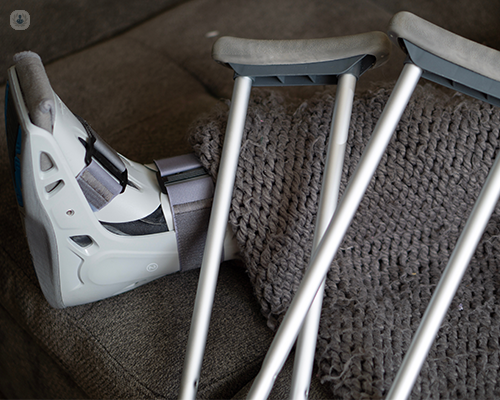Post-op instructions: when can I walk after ankle arthroscopy?
Written by:You’re likely itching to get back to normal as soon as possible after an operation, especially one involving your ankle. Mr Tarek El Gamal, a consultant orthopaedic surgeon and expert in ankle arthroscopy, clarifies what you can expect regarding recovery. This includes explanations of how long to wait before you bear weight on the foot as well as when you can walk, return to work and get back to sports.

How long should I wait to walk on the foot?
Ankle arthroscopy is a very versatile operation which can include multiple procedures in the same setting. When it comes to bearing weight on the ankle post-op, 90 per cent of patients are asked to immediately bear weight on their ankle.
The remaining 10 per cent are the ones who required microfracture surgery, a procedure which aids the regeneration of the joint lining and cartilage after damage. In these cases, the patient is asked to not bear any weight on their ankle for six weeks.
Will I need crutches or any support?
The need for a walking aid is quite variable. On the day of surgery, the patient is assessed immediately by a physiotherapist to evaluate if they’ll need crutches. In my experience, most of the patients will require one or two crutches for 10-15 days.
How long will I need off work to recover?
Patients usually need two to four weeks off work and this is simply for rehabilitation purposes. Immediately post-op, the patient is asked to keep the foot elevated along with mobilising the ankle through the range of motion. Early mobilisation is vital for minimising swelling and restoring function.
Will I be able to return to sports?
Patients are advised to avoid contact sports for two months. However, a patient could start with zero to low impact sports once the wound heals, which is usually two to three weeks after the operation. Low impact sports include swimming, rowing and cycling.
What type of complications could occur?
Any surgery comes with risks. However, ankle arthroscopy has got a very high rate of patient satisfaction – 94 per cent according to literature. It also has very low complication rates. Rare complications with ankle arthroscopy are
- Nerve injury
- Swelling
- Bleeding
- Pain
- Stiffness
- Recurrence of symptoms
Most of those complications are avoidable with early rehabilitation and hard work from the patient.
I always tell my patients, “Surgery is step one of your rehab, step two and ten are the hard work you are going to do after surgery.”
When will I know the procedure was successful?
Because the ankle is a weight-bearing joint, it can take up to two months to feel the benefits of ankle arthroscopy.
To learn how Mr El Gamal’s first-class orthopaedic services can benefit you, visit his profile and arrange your consultation.


